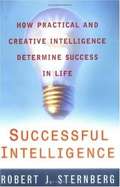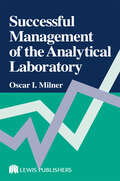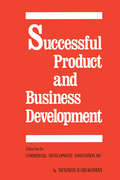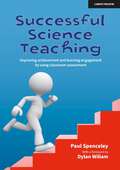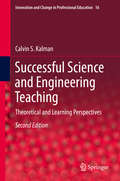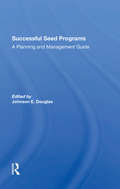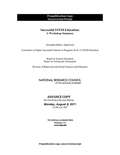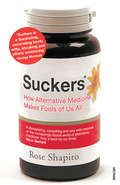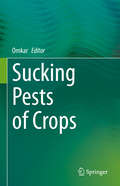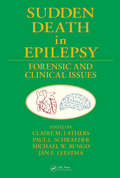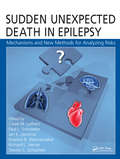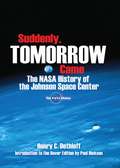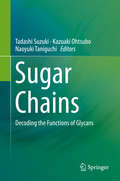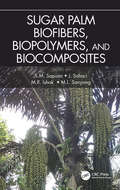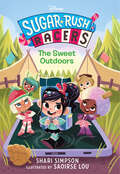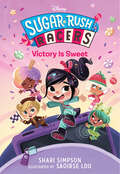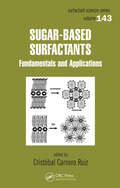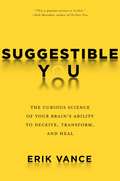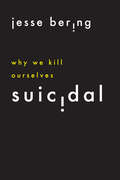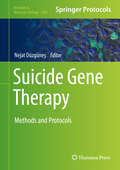- Table View
- List View
Successful Intelligence: How Practical and Creative Intelligence Determines Success in Life
by Robert SternbergIn response to the current buzz surrounding such books as "Emotional Intelligence" and "The Bell Curve," Yale University professor Robert Sternberg challenges the age-long debate over nature vs. nurture. Proposing that nurture is far more important than nature in determining success in life, he challenges this critical debate about how to best evaluate and teach America's youth. Sternberg argues that traditional IQ tests and standardized tests measure only 'inert' intelligence, and are therefore poor predictors of how students will do in life. SATs and other standardized tests only evaluate our ability to memorize material and perpetuate the labeling of students based on often irrelevant criteria. "Successful Intelligence" offers specific ways to develop practical and creative intelligence, it demonstrates how accomplished people make successful intelligence work for them, it shows how members of various ethnic groups who typically do not do as well on tests of academic intelligence can compete successfully on creative and practical intelligence and it tells readers that the willingness to take risks and overcome obstacles is a key attribute for achieving intelligence. Sternberg provides us with a new definition of intelligence that predicts how students will fare in problem-solving in both their personal and professional lives. With the keys on how to achieve life's more important goals, Successful Intelligence will change the way we regard aptitude and intelligence.
Successful Management of the Analytical Laboratory
by Oscar I. MilnerSuccessful Management of the Analytical Laboratory provides a comprehensive discussion of the problems that face analytical laboratory managers and presents proven techniques for improving the operation and performance of analytical labs. A wide range of topics are covered, including functions of various laboratory types (including a discussion of
Successful Product and Business Development, First Edition
by N. GiragosianThis book shows how the people carrying out industrial commercial development perform the vital functions and deals with the organization and structure of commercial development. It describes the change in thinking of chemical companies from a product-oriented outlook to a business-oriented one.
Successful Science Teaching: Improving achievement and learning engagement by using classroom assessment
by Paul SpenceleyTeachers simply do not have the time to do any more work. Yet the pressure to improve results is ever-upwards. The emphasis in this book is not on doing anything extra, but on doing all the everyday things that science teachers do – planning lessons, marking work and exams, providing feedback, and getting students involved in discussions, or self and peer-assessment – in a slightly different way. The book is full of simple, practical, formative assessment techniques and strategies, based on real classroom practices, repeated across the range of ages and abilities at secondary levels, in a variety of schools, that have been repeatedly shown to significantly improve examination results, and student involvement in lessons. Whether you are just about to embark on a career as a science teacher, or you have been one for many years, there is bound to be something here.
Successful Science Teaching: Improving achievement and learning engagement by using classroom assessment
by Paul SpenceleyTeachers simply do not have the time to do any more work. Yet the pressure to improve results is ever-upwards. The emphasis in this book is not on doing anything extra, but on doing all the everyday things that science teachers do – planning lessons, marking work and exams, providing feedback, and getting students involved in discussions, or self and peer-assessment – in a slightly different way. The book is full of simple, practical, formative assessment techniques and strategies, based on real classroom practices, repeated across the range of ages and abilities at secondary levels, in a variety of schools, that have been repeatedly shown to significantly improve examination results, and student involvement in lessons. Whether you are just about to embark on a career as a science teacher, or you have been one for many years, there is bound to be something here.
Successful Science and Engineering Teaching
by Calvin S. KalmanThe intent of this book is to describe how a professor can provide a learning environment that assists students to come to grips with the nature of science and engineering, to understand science and engineering concepts, and to solve problems in science and engineering courses. As such, this book is intended to be useful for any science or engineering professor, who wants to change their course to include more effective teaching methods, to instructors at post-secondary institutions, who are beginning their careers, and as a handbook for TA s. Since the book is based upon articles that I have had published in Science Educational Research and which are grounded in educational research that I have performed (both quantitative and qualitative) over many years, it will also be of interest to anyone engaged in research into teaching science and engineering at the post-secondary level. I have also tried to include enough background so that the book could be used as a textbook for a course in educational practice in science and engineering. The book has two main axes of development. Firstly, how do we get students to change their epistemology so that their outlook on the course material is not that it consists of a tool kit of assorted practices, classified according to problem type, but rather that the subject comprises a connected structure of concepts. Secondly, helping students to have a deeper understanding of science and engineering. "
Successful Seed Programs: A Planning And Management Guide
by Johnson E. DouglasThis book provides the administrator with a basic reference for assessing the stage of development of the seed program, identifying needs, developing plans, and taking actions necessary to build a successful seed program to help managers and leaders to plan and implement successful activities.
Successful Stem Education
by The National Academy of SciencesWhat students learn about the science disciplines, technology, engineering, and mathematics during their K-12 schooling shapes their intellectual development, opportunities for future study and work, and choices of career, as well as their capacity to make informed decisions about political and civic issues and about their own lives. Most people share the vision that a highly capable STEM workforce and a population that understands and supports the scientific enterprise are key to the future place of the United States in global economics and politics and to the well-being of the nation. Indeed, the solutions to some of the most daunting problems facing the nation will require not only the expertise of top STEM professionals but also the wisdom and understanding of its citizens. Although much is known about why schools may not succeed, it is far less clear what makes STEM education effective. Successful STEM Education: A Workshop Summary discusses the importance of STEM education. The report describes the primary types of K-12 schools and programs that can support successful education in the STEM disciplines and examines data and research that demonstrate the effectiveness of these school types. It also summarizes research that helps to identify both the elements that make such programs effective and what is needed to implement these elements.
Suckers: How Alternative Medicine Makes Fools of Us All
by Rose Shapiro'Alternative' medicine is now used by one in three of us. In the UK we spend an estimated £4.5 billion a year on it and its practitioners are now insinuating themselves into the mainstream. There are methods based on ancient or far-eastern medicine, as well as ones invented in the nineteenth and twentieth centuries. Many are promoted as natural treatments. What they have in common is that there is no hard evidence that any of them work. Treatments like homeopathy, acupuncture and chiropractic are widely available and considered reputable by many. Ever more bizarre therapies, from naturopathy to nutraceuticals, ear candling to ergogenics, are increasingly favoured. Endorsed by celebrities and embraced by the middle classes, alternative medicine's appeal is based on the spurious rediscovery of ancient wisdom and the supposedly benign quality of nature. Surrounded by an aura of unquestioning respect and promoted through uncritical airtime and column inches, alternative medicine has become a lifestyle choice. Its global market is predicted to be worth $5 trillion by 2050.Suckers reveals how alternative medicine can jeopardise the health of those it claims to treat, leaches resources from treatments of proven efficacy and is largely unaccountable and unregulated. In short, it is an industry that preys on human vulnerability and makes fools of us all. Suckers is a calling to account of a social and intellectual fraud; a bracing, funny and popular take on a global delusion.
Sucking Pests of Crops
by OmkarSucking pests are most notorious group of pests for agricultural crops. Unlike most pests with chewing mouth parts, sucking pests cause more severe damage to the crops and are complex to get identified until advanced stages of infection. Not only is this late detection detrimental to their effective control, sucking pests also often cause fungal growth and virus transmission. The book emphasizes on sucking pests of most major crops of India. It aims to reflect Indian scenario before the international readership. This book complies comprehensive information on sucking pests of crops and brings the attention of the readers to this multiple damage causing insect complex. The chapters are contributed by highly experienced Indigenous experts from Universities & ICAR institutes, and book collates useful content for students and young researchers in plant pathology, entomology and agriculture.
Sudden Death in Epilepsy: Forensic and Clinical Issues
by Jan E. Leestma Claire M. Lathers Paul L. Schraeder Michael W. BungoThough it is one of the most common causes of death in epilepsy patients, SUDEP is still infrequently and even reluctantly named on autopsy reports. This under-reporting equates to a lack of attention and earnest investigation into the cause, predisposition, and prevention of SUDEP. There is as yet little effort to establish an actionable strategy
Sudden Unexpected Death in Epilepsy: Mechanisms and New Methods for Analyzing Risks
by Steven C. Schachter Jan E. Leestma Claire M. Lathers Paul L. Schraeder Braxton B. Wannamaker Richard L. VerrierSudden Unexpected Death in Epilepsy: Mechanisms and New Methods for Analyzing Risks builds on earlier works focusing on the clinical problem of sudden unexpected death in epilepsy (SUDEP). This book presents a methodology for identifying and classifying clusters of risks that lead to SUDEP. Developed over the last two years, the SUDEP Classificatio
Suddenly, Tomorrow Came: The NASA History of the Johnson Space Center (Dover Books on Astronomy)
by Paul Dickson Henry C. DethloffAs the astronauts' home base and the site of Mission Control, the Johnson Space Center has witnessed some of the most triumphant moments in American history. Spanning initiatives from the 1960s to 1993, this illustrated volume traces the center's history, starting with its origins at the beginning of the space race in the late 1950s. Thrilling, authoritative accounts explain the development and achievements of the early space voyages; the lunar landing; the Mercury, Gemini, and Apollo programs; and the space shuttles and international space station. As astronaut Donald K. Slayton notes in his Foreword, this chronicle emphasizes the cooperation of "humans on space and on the ground. It realistically balances the role of the highly visible astronaut with the mammoth supporting team." An official NASA publication, Suddenly, Tomorrow Came is profusely illustrated with forty-four figures and tables, plus sixty-three photographs. Historian Paul Dickson brings the narrative up to date with an informative new Introduction.
Sugar Chains
by Tadashi Suzuki Kazuaki Ohtsubo Naoyuki TaniguchiThis book presents the latest breakthrough results in glycobiology regarding the roles of glycans in relation to quality control and transport of protein, the immune system, viral infection, stem cells, the neural system, and various diseases such as cancer, diabetes, chronic obstructive pulmonary disease, muscular dystrophy, and schizophrenia. Although glycoscience has long been regarded as a very specialized field with no simple analytical method, the recent explosive progress in research continues to provide limitless evidence that glycan chains are the key component in various biological phenomena. Cell surface glycans, for example, change with developmental stages or environmental conditions and thus represent a "face" of the cell that is utilized for identification of iPS and ES cells and as biomarkers in diagnosis or detection of cancer. This book comprises 17 chapters, each of which poses outstanding "glyco-related" questions enabling non-specialists to have a clearer idea about what the future direction for further investigation of glycans in their own research fields will be. Also including basic information to understand the nature of glycans, this title serves as an excellent "textbook" for researchers in diverse research fields who are not familiar with, but nevertheless interested in, glycan chains or sugar chains.
Sugar Palm Biofibers, Biopolymers, and Biocomposites
by S. M. Sapuan J. Sahari M. R. Ishak M. L. SanyangNatural fibre composites are increasingly being viewed as viable and environmentally responsible alternatives to synthetic fibre composites and plastics. Sugar Palm Biofibers, Biopolymers, and Biocomposites considers the use of sugar palm fibres for materials development and application. It offers original research on the properties and behavior of sugar palm’s fibres, polymers, and biocomposites, covering mechanical, physical, thermal, chemical, environmental, morphological properties, as well as optimal design. It discusses sugar palm fibre thermosetting composites, sugar palm fibre thermoplastic composites, impregnation of sugar palm fibre, various lengths of sugar palm fibres, forms and arrangements such as particulate, continuous roving, and woven fabrics. The book also discusses innovations in commercialized products derived from sugar palm.
Sugar Rush Racers: The Sweet Outdoors (Sugar Rush Racers)
by Shari SimpsonThe Sugar Rush Racers from WRECK-IT RALPH are catapulted out of their arcade game and into the world of a young girl named Molly, in this chapter book series.Molly can't wait for her camping trip with troop! Until she learns there are NO DEVICES ALLOWED, but the Sugar Rush Racers convince Molly to sneak her tablet into the camping trip. Everyone knows the best part of the trip is the scavenger hunt but when the team get lost and Molly pulls out her tablet to try to help, everyone turns on her for breaking the rules. How will the Sugar Rush Racers help her get out of this one!Add the other candy-coated title to your collection: Victory is Sweet
Sugar Rush Racers: Victory is Sweet (Sugar Rush Racers)
by Shari SimpsonVanellope Von Schweetz and the other racers from Sugar Rush are catapulted out of their arcade game and into the world of a young girl named Molly, in this chapter book series.Molly McGinty is surprised when she comes home from the arcade and Vanellope and her friends are in her tablet! But when she fights with her best friend and needs help with her go-kart she has no one to turn to but the Sugar Rush Racers. Everyone has to work together as a team to accomplish the goals.Add the other candy-coated title to your collection: The Sweet Outdoors
Sugar and Sugar Derivatives: Changing Consumer Preferences
by Priyanka Singh Narendra MohanSugarcane enjoys a prominent position among agro-industrial crops and is commercially grown in 115 tropical and subtropical countries around the world. However, fluctuations in sugar prices have forced the sugarcane industry worldwide to broaden its revenue base by moving from single-commodity manufacturing to a range of value-added products. Utilizing the by-products in an innovative manner to create value-added products is the new course of action for sugar-producing countries. For many years sugarcane was regarded as a single-product crop, i.e., only useful for producing sugar. Its actual potential is now increasingly being recognised by the industry and there is a growing trend toward the manufacturing of allied products from sugarcane. Therefore, the focus is now on the establishment of sugar-agro-industry complexes, processing not just sugar but a range of other products. This book provides a comprehensive overview of sugarcane not only as a source of sweetening agents but also for many other uses, including as a source of bio-energy. It also explores the trend of sugar consumption and suggests practices to curb the consumption of sugar products in order to tackle obesity and reduce public health costs. The book underscores the need to diversify sugarcane and highlights means of doing so, while also addressing various innovations and technologies being developed in connection with sugar, sugar derivatives, and sugar industry by-products for sustainable utilization in the sugar-agro industry. Accordingly, it offers a valuable resource for professionals and R&D units in the sugar industry, and for students of agronomy and related fields.
Sugar-Based Surfactants: Fundamentals and Applications
by Cristóbal Carnero RuizTouted as the new darling of the chemical industry, alkyl polyglycosides are gaining in popularity due to the fact that they are readily biodegradable, low-toxic, and made from renewable resources. Sugar-Based Surfactants compiles the most recent and relevant aspects of sugar-based surfactants, including self-association, phase behavior, and interf
Sugarcane Biofuels: Status, Potential, and Prospects of the Sweet Crop to Fuel the World
by Muhammad Tahir Khan Imtiaz Ahmed KhanSugarcane exhibits all the major characteristics of a promising bioenergy crop including high biomass yield, C4 photosynthetic system, perennial nature, and ratooning ability. Being the largest agricultural commodity of the world with respect to total production, sugarcane biomass is abundantly available. Brazil has already become a sugarcane biofuels centered economy while Thailand, Colombia, and South Africa are also significantly exploiting this energy source. Other major cane producers include India, China, Pakistan, Mexico, Australia, Indonesia, and the United States. It has been projected that sugarcane biofuels will be playing extremely important role in world’s energy matrix in recent future.This book analyzes the significance, applications, achievements, and future avenues of biofuels and bioenergy production from sugarcane, in top cane growing countries around the globe. Moreover, we also evaluate the barriers and areas of improvement for targeting efficient, sustainable, and cost-effective biofuels from sugarcane to meet the world’s energy needs and combat the climate change.
Sugars That Heal: The New Healing Science of Glyconutrients
by Emil I. Mondoa"Sugars that heal" it sounds like a contradiction in terms, but it's the key to one of the most important breakthroughs in recent medical science. We've all been bombarded with warnings about the evils of consuming too much sugar. But, in fact, for our bodies to function properly, we need small amounts of eight essential sugars, only two of which--glucose and galactose--are commonly found in our limited, overprocessed diets. When all eight sugars are available, the health benefits can be breathtaking: Individuals regain their ability to fight disease, reactivate their immune systems, and are able to ward off infection. Based on cutting-edge research in the rapidly evolving science of glyconutrients, Sugars That Heal is an exciting new approach to health and disease prevention.As medical doctor and scientific researcher Emil Mondoa explains, these eight essential sugars, known as saccharides, are the basis of multicellular intelligence--the ability of cells to communicate, cohere, and work together to keep us healthy and balanced. Even tiny amounts of these sugars--or lack of them--have profound effects. In test after test conducted at leading institutes around the world, saccharides have been shown to lower cholesterol, increase lean muscle mass, decrease body fat, accelerate wound healing, ease allergy symptoms, and allay autoimmune diseases such as arthritis, psoriasis, and diabetes. Bacterial infections, including the recurrent ear infections that plague toddlers, often respond remarkably to saccharides, as do many viruses--from the common cold to the flu, from herpes to HIV. The debilitating symptoms of chronic fatigue syndrome, fibromyalgia, and Gulf War syndrome frequently abate after adding saccharides. And, for cancer patients, saccharides mitigate the toxic effects of radiation and chemotherapy--while augmenting their cancer-killing effects, resulting in prolonged survival and improved quality of life. Sugars That Heal offers a revolutionary new health plan based on the science of glyconutrients--foods that contain saccharides. It gives authoritative guidance for getting all eight saccharides conveniently into your diet through supplements and readily available foods, as well as detailed information on correct dosages. Here, too, are chapters dealing with the special nutritional needs of people suffering from cancer, heart disease, asthma, and neurological disorders, and methods for using glyconutrients to treat depression, obesity, and ADHD.The more doctors learn about glyconutrients, the more excited they become about their long-term fundamental health benefits. Now, with this new book, the breakthroughs in the study of glyconutrients are available to everyone. Whether your goal is to prevent disease, live longer and better, or treat a serious illness that has eluded conventional medicine, Sugars That Heal is your essential guide to complete health.From the Hardcover edition.
Suggestible You: The Curious Science of Your Brain's Ability to Deceive, Transform, and Heal
by Erik VanceThis riveting narrative explores the world of placebos, hypnosis, false memories, and neurology to reveal the groundbreaking science of our suggestible minds. Could the secrets to personal health lie within our own brains? Journalist Erik Vance explores the surprising ways our expectations and beliefs influence our bodily responses to pain, disease, and everyday events. Drawing on centuries of research and interviews with leading experts in the field, Vance takes us on a fascinating adventure from Harvard's research labs to a witch doctor's office in Catemaco, Mexico, to an alternative medicine school near Beijing (often called "China's Hogwarts"). Vance's firsthand dispatches will change the way you think--and feel. Expectations, beliefs, and self-deception can actively change our bodies and minds. Vance builds a case for our "internal pharmacy"--the very real chemical reactions our brains produce when we think we are experiencing pain or healing, actual or perceived. Supporting this idea is centuries of placebo research in a range of forms, from sugar pills to shock waves; studies of alternative medicine techniques heralded and condemned in different parts of the world (think crystals and chakras); and most recently, major advances in brain mapping technology. Thanks to this technology, we're learning how we might leverage our suggestibility (or lack thereof) for personalized medicine, and Vance brings us to the front lines of such study.
Suicidal: Why We Kill Ourselves
by Jesse BeringThis personal inquiry into the psychology of suicide brings “compassion, confessional honesty, and academic perception” to a woefully misunderstood subject (Kirkus Reviews).Despite his success as a psychologist and writer, Jesse Bering spent most of his thirties believing he would probably kill himself. At times, the impulse to take his own life felt all but inescapable. When his suicidal thoughts began to fade, he felt relieved—but also curious. He wondered where they came from and if they would return; whether other animals experienced the same impulse, or if it was a uniquely human evolutionary development. In Suicidal, Bering answers all these questions and more.Drawing on personal stories, scientific studies, and remarkable cross-species comparisons, Bering explores the science and psychology of suicide. Revealing its cognitive secrets and the subtle tricks our minds can play on us, Bering helps readers analyze their own doomsday thoughts while gaining broad insight into the subject. Authoritative, accessible, personal, and profound, Suicidal will change the way you think about this most vexing of human problems.
Suicide Gene Therapy: Methods and Protocols (Methods in Molecular Biology #1895)
by Nejat Düzgüneş<p>This detailed volume explores the methods used for most of the recent approaches to suicide gene therapy of cancer, which exploits promoters that are specific to cancer cells, thereby ensuring (or greatly increasing the likelihood) that the therapeutic gene is expressed only in cancer cells. The book also contains chapters describing methods to improve the safety of cell therapy and techniques utilizing bone marrow mesenchymal cells. Written for the highly successful Methods in Molecular Biology series, chapters include introductions to their respective topics, lists of the necessary materials and reagents, step-by-step, readily reproducible laboratory protocols, and tips on troubleshooting and avoiding known pitfalls. <p>Authoritative and practical, Suicide Gene Therapy: Methods and Protocols serves as an ideal guide for researchers expanding upon our knowledge and application of this vital form of cancer therapy.</p>
Suicide Postvention in the Department of Defense: Evidence, Policies and Procedures, and Perspectives of Loss Survivors
by Rajeev Ramchand Dionne Barnes-Proby Gail Fisher Lynsay Ayer Karen Chan Osilla Samuel WertheimerA review of the scientific evidence on suicide postvention (organizational responses to prevent additional suicides and help loss survivors cope), guidance for other types of organizations, and the perspectives of the family and friends of service members who have died by suicide provide insights that may help the U. S. Department of Defense formulate its own policies and programs in a practical and efficient way.
